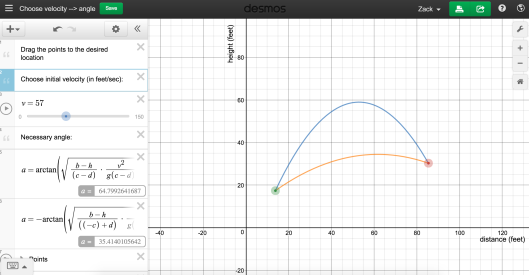About 18 months ago, I hung up my teaching shoes and became a “Teacher on Special Assignment” for my charter school network. I’ve found it challenging to describe what exactly the “special assignment” is to friends, family, and colleagues. In short, I am leading an 18-month-long-and-counting effort to transform our network’s approach to math curriculum, instruction, and assessment. Most people in our organization, when asked what my job is, will give you a much simpler answer (with varying degrees of sarcasm): fix math. Whatever we’re calling it, it’s been an incredible challenge and epic professional adventure that I’m long overdue to blog about. Over the next few weeks, I’m going to chronicle the twists and turns. Most importantly, I plan to share my learnings that will hopefully benefit others wrestling with similar challenges. Let’s start at the beginning:
Back in 2013, my organization shifted to project-based learning (PBL) in all courses, for all grades. I viewed this as an exciting shift at the time. Even upon reflection, teaching in that model changed my instruction for the better in many ways (many of which I’ve written about on this blog): kids were reading and writing lots; math practices and cognitive skills (aka 21st century skills) became more of a focus in my classroom; students with vastly different math proficiencies collaborated meaningfully; and kids produced awesome final products that they (and their parents) were proud of. Over three years later, I still get random emails from former students recalling a project we did that was meaningful to them and has stuck with them.
The shift to PBL had challenging aspects, too; often very fun challenges. When my 9th grade students were doing their Projectile Motion projects, for example, they were unsatisfied with the constraints I gave (limiting study to objects launched straight up or down, so as to work with a standard quadratic function). They were curious how to model projectiles launched at an angle, and – not knowing much about physics myself – I was curious too! That curiosity led me and the students on a thrilling, unexpected mathematical journey.
Some of the challenges involved in our PBL-shift, though, led me to the conclusion that something still wasn’t quite right with how we were structuring our math classes. At the time, Geoff Krall’s writing about being in a similar position resonated with me and my experience. Here’s how:
- I noticed the perils of the “product-focused” project. Students spent too much time perfecting their PowerPoints or their posters; time that could have been spent doing deep mathematical thinking.
- I noticed that orienting 5 weeks of instruction around a product often meant a disjointed treatment of mathematical concepts. I taught whatever was needed to move the project forward, which sometimes meant the projects lacked mathematical coherence.
- I noticed that students responded well to projects where the connection between the math and the project’s real-world context felt natural; but sometimes math topics didn’t lend themselves well to a prolonged project involving a real-world context, and forcing those topics into a math project felt inauthentic and led to occasional tough stretches for me and my students.
- I wondered if a problem-based learning could accomplish a lot of the things I loved about project-based learning (and more), and avoid some of the aforementioned pitfalls.
Reading Common Core’s definition of rigor further convinced me that we shouldn’t limit ourselves to doing only projects in the math classroom. The definition refers to procedural fluency, conceptual understanding, and application. Projects gave us the application component, and my school also had a system for procedural fluency, but conceptual understanding got the short end.
I believed that to provide a more rigorous classroom as defined by Common Core and others, especially one that gave sufficient emphasis to conceptual understanding, we needed a combination of project- and problem-based experiences in our math classes. I decided that this effort would be my “special assignment.” Making that decision was the first domino that has set the wild past 18 months in motion. I’m excited to share more; stay tuned.


Can’t wait to read more 🙂
We have some aspects of PBL at our school, and here are a few things that I found helped us to avoid some pitfalls. I wonder if that’s what you mean when you mention combining problem with project based.
1. While the final product is important, displayed and celebrated , we start with the question/problem and develp it together with students. Often our ideas on what the project will be change in a process.The main focus is on learning intentions, on what students will learn and how will I assess it not what students will produce.
2. We integrate multiple subjects. Powerpoint can be combined with LA class, if there is any need to dive deeper into science, we can do it during science time. Art flows beautifully with math. I teach elementary and it is easier to integrate, but I heard from colleagues at middle and high schools that it’s possible too.
3. Point 2 gives you back math time that can be used on building a better conceptual background for what otherwise might end up as a set of disjointed skills.
Thanks for the comment. If I’m understanding your 3 bullets correctly, it sounds like what you’re describing is the poetic ideal of project-based learning practices (not problem-based learning). If you’re doing these and getting great results, I’d love to learn more; I aspire to do everything you mention, but I find it quite difficult in practice. For example, I’d love if we could focus on the *learning* not the product, as you said, but how? I’d love if we could integrate multiple subjects more regularly, but coordinating the project across multiple classes and finding planning time for the teachers proved challenging.
Most importantly, I wish we could do your 3rd bullet (focus more on conceptual understanding). Unfortunately, time is only *one* of the obstacles. As I wrote about in the next post in this series, ensuring a coherent student experience through the project often comes at the expense of a coherent thread of the mathematical concepts. I don’t see projects as a great vehicle for teaching all of the important math concepts – that’s where problem-based learning comes in, as I see it.
Regarding integrating across multiple classroom, I found it very challenging logistically, and definitely easier at elementary level. We have some time designated by our admin for team planning/developing and tracking the progress of our projects that certainly helps.
The biggest difference though it that we have a couple of big projects a year that have a celebration at the end, planning time, extra materials budget. As focusing more on the learning goals goes, problems and practice are part of the process. There are lessons that are not directly related to the planned final product, but more time=more flexibility.
I found your post interesting and had an urge to reply because I find that despite all that I often struggle with coherence of my curriculum and I am putting a lot of time into planning. But for me longer projects that don’t take up all your instructional time in a given week and more teamwork between teachers helped a lot.
I also agree that I can’t envision teaching everything through projects. Some concepts seem a better fit, and I would be still taking multiple steps back during the project for concept, skill and problem-solving lessons.
For example, last year kids were exploring Islamic Geometric Art, and at the end created their own geometric art constructions. Creating the final product piece took probably 2 weeks. All the prep work and learning across different subjects took over two preceeding months. Before the final piece, we had a lot of mini-projects embedded (from creating circle art to solving fractions puzzles to writing poetry). My goal was to hit all my geometry outcomes and to reinforce some concepts related to fractions. Multiplication also came in handy when calculating perimeters of regular polygons. The project alone would not be sufficient to work with multiplication. Number talks, problems, games were all done parallel to the project.
Thank you again for sharing your thoughts, I will be following your next posts.
Thanks for elaborating. The system you describe is exactly what I ended up pushing for: instead of 8 projects like we currently had, go big on 2 projects, and when not working towards projects, spending a lot of time developing important mathematical concepts. In other words, I like the idea of projects being important and being centerpieces of the curriculum to some extent, but not everything should be a project. Sometimes, leaving the “problem space” of a project to develop concepts is necessary. I’ll be blogging soon about how that went!
Thank you for the post! I too am intrigued to learn more about this effort.
I am very curious about how much stakes (for lack of a better word) your charter district is placing on the math content of the “content standards” published in various standards documents since 1989? Maybe this is explicit, or maybe there remains some tension about the “invisible math” kids must know for college entrance tests or future (college, career, life, etc.) success.
Many schools I have observed and/or worked with in the shift you are taking up fail to leave a paradigm that fails to remove these barriers to real learning. I am very curious about schools or districts who are intentional in that sort of paradigm change that underlies their efforts at “fixing math.”
Best wishes — and keep us posted! 🙂
Thanks for the comment, Brian. Since college is a core part of our mission, it is important that we prepare students for the tests that act as gatekeepers for our students. Additionally, as a charter network that constantly needs to justify its own existence, external assessments do matter to us.
Our feeling about our state’s old standards was that procedures were over-emphasized. The standards felt obsolete. When CCSS was on its way in, this was a welcomed departure from our state’s “traditional content standards,” especially with the inclusion of math practice standards, and so this partly enabled our shift to PBL. As I’m arguing in this series, my org’s shift to PBL accomplished a lot, but it was an overcorrection. We de-emphasized some math that was rightfully obsolete, but also some math that was important (perhaps this is the “invisible math” you’re referring to)! This series – my whole blog – is about trying to focus on the math that matters.
Pingback: Transforming a Math Program, Pt. 2: Nesting problems in projects | A Math Education That Matters
After having some brief convo’s and reading more about Summit etc, can’t wait to read more about this/conversation on twitter etc too!
Pingback: Transforming a Math Program, Pt. 3: Assessing what we value | A Math Education That Matters